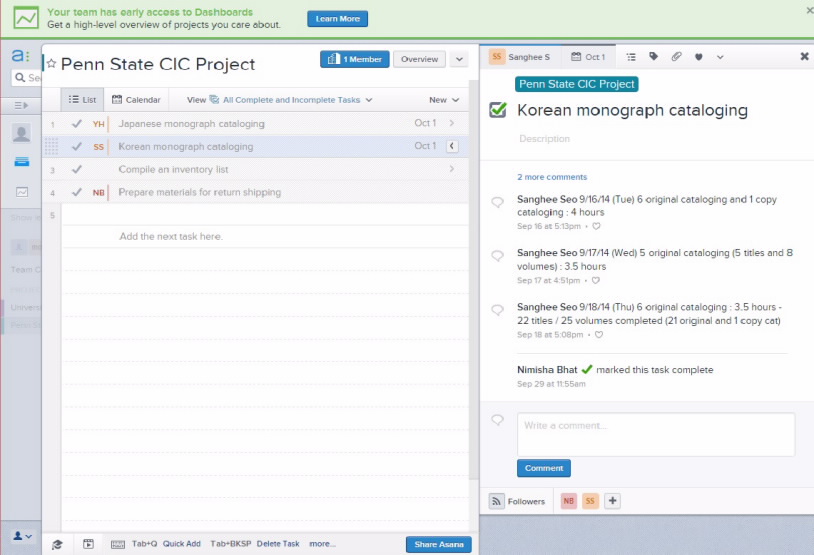As coordinator for non-Roman language cataloging at my library, I have to keep track of several workflows simultaneously without actual fluency in any of the 10+ languages that my section deals with. As a librarian it goes without saying that I’m a big fan of organization and efficiency. So I’ve implemented a free task-based program called Asana in order to keep track of my section’s productivity, statistics, and progress.
Asana was created with the objective of eliminating dependability on email in order to manage projects. Tasks and conversations are all in one place to promote transparency and accessibility, which is extremely valuable when you are on a team of five or more people with multiple established workflows. I’m certain I’m not alone when I say that email can often seem like a void that creates more confusion than clarity when it comes to communicating important work updates. Not everyone that I have to correspond with is well-versed in the proper use and etiquette involved with emailing, which often inspires me to do this:

With Asana, I have the ability as a project manager to create a timeline with due dates, assign particular tasks to people as needed, organize initiatives & meetings, and keep track of progress all in one interface. This also cuts down on the necessity for constant meetings and prevents things from falling by unnoticed in an email thread where there are already twenty-some responses and everyone is using the Reply All button.
I have been primarily using Asana to organize cooperative cataloging projects in my section. My library is a member of several initiatives to connect with other academic institutions (e.g. the CIC) in order to catalog materials on behalf of a fellow library that may not have staff who can create bibliographic records in a particular language or format.

Here, a team member is able to log their progress on tasks assigned to them, keep track of the established timeline, and upload documents like title inventories. Having all this information in one (free!) place makes it easier for a project manager to create reports and to aggregate statistics. I’ve successfully implemented Asana for two cooperative cataloging projects thus far.
Have you used Asana in your library? Do you have a favorite task managing program?
Michael Rodriguez
I feel that librarians are infinitely more progressive in their embrace and useful implementation of technologies than the business sector is. I was vastly amused when I had to learn MS Project – Microsoft products, really? – for a business project management class I’m taking at MPOW (luckily, classes are free for employees). Meanwhile, I’m using Trello in my job. ¯_(?)_/¯
Nimisha Bhat
Agreed! I also think there’s a type of guerrilla-ingenuity that comes along with librarians utilizing technologies in order to solve problems. “Is it free? Can you easily present it to team members and stakeholders? Then do it!” is usually the attitude I’ve received in libraries, and it’s great.
Michael Rodriguez
Someone on Twitter once said that librarians are the MacGyvers of the tech world. Yes.